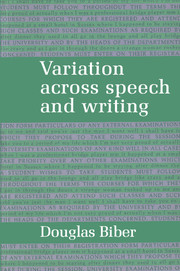Book contents
- Frontmatter
- Contents
- List of figures
- List of tables
- Acknowledgments
- Part I Background concepts and issues
- 1 Introduction: textual dimensions and relations
- 2 Situations and functions
- 3 Previous linguistic research on speech and writing
- Part II Methodology
- Part III Dimensions and relations in English
- Appendix I Texts used in the study
- Appendix II Linguistic features: algorithms and functions
- Appendix III Mean frequency counts of all linguistic features in each genre
- Appendix IV Pearson correlation coefficients for all linguistic features
- References
- Index
2 - Situations and functions
Published online by Cambridge University Press: 05 June 2012
- Frontmatter
- Contents
- List of figures
- List of tables
- Acknowledgments
- Part I Background concepts and issues
- 1 Introduction: textual dimensions and relations
- 2 Situations and functions
- 3 Previous linguistic research on speech and writing
- Part II Methodology
- Part III Dimensions and relations in English
- Appendix I Texts used in the study
- Appendix II Linguistic features: algorithms and functions
- Appendix III Mean frequency counts of all linguistic features in each genre
- Appendix IV Pearson correlation coefficients for all linguistic features
- References
- Index
Summary
This study is based on both macroscopic and microscopic analyses of textual variation (see Section 4.1). Macroscopic analyses identify the dimensions of variation among texts and specify the overall relations among genres with respect to those dimensions. Microscopic analyses describe the functions of linguistic features in relation to the speech situations of individual texts. Linguistic features mark particular components of the situation, in addition to their functions as markers of relations within a text. In this chapter, I describe the salient components of the speech situation and provide a brief overview of the major communicative functions served by linguistic features. I then turn to the situational and functional differences between ‘typical’ speaking and writing and propose a framework for comparing more or less typical genres in terms of their situational characteristics.
Components of the speech situation
There are several studies that catalog the components of the speech situation, which provides the situational context for ‘speech events’. One of the earliest and most complete descriptions is presented in Hymes's (1974:53ff) components of speech, which include message form, message content, speaker, hearer, purposes, key, channels, and norms of interaction. This description is further elaborated by Duranti (1985). Fishman (1972) identifies three primary components of the situation of language use: (1) the participants and the relationship among them, (2) the topic, and (3) the setting. Halliday (1978) also distinguishes among three components of the communicative situation: (1) the type of social action (the ‘field’), (2) the role relationships (the ‘tenor’), and (3) the symbolic organization (or ‘mode’).
Information
- Type
- Chapter
- Information
- Variation across Speech and Writing , pp. 28 - 46Publisher: Cambridge University PressPrint publication year: 1988
